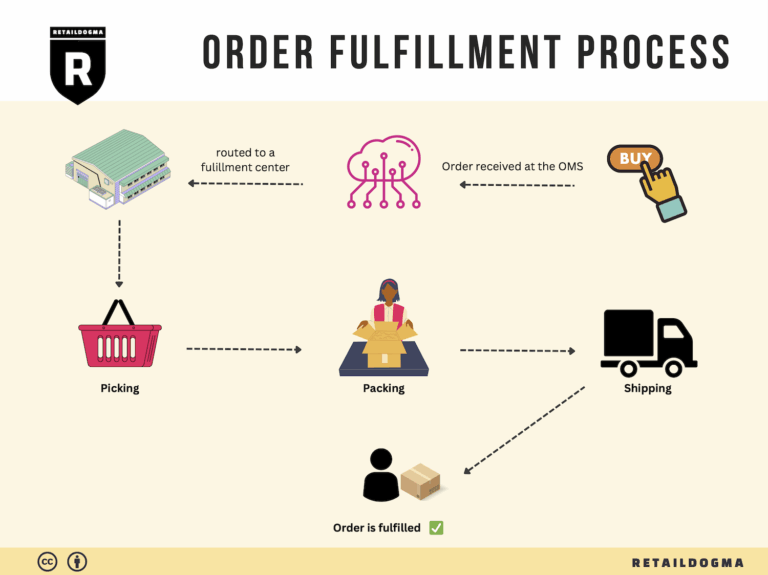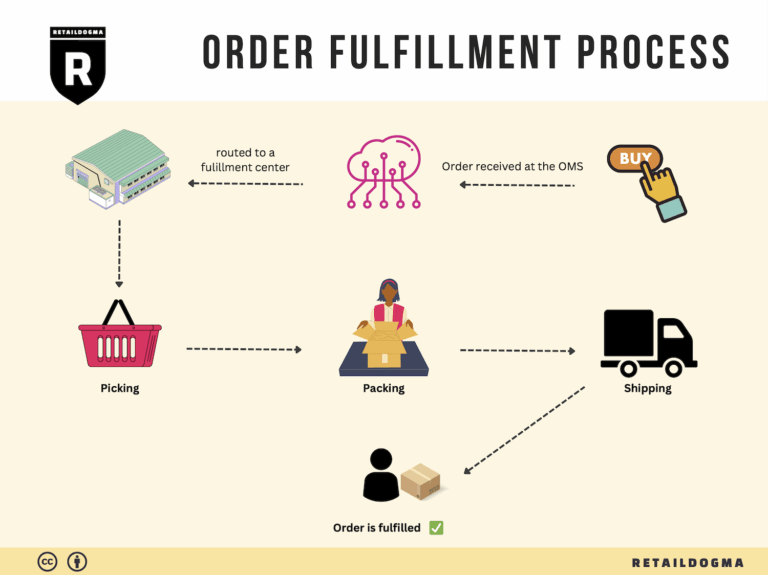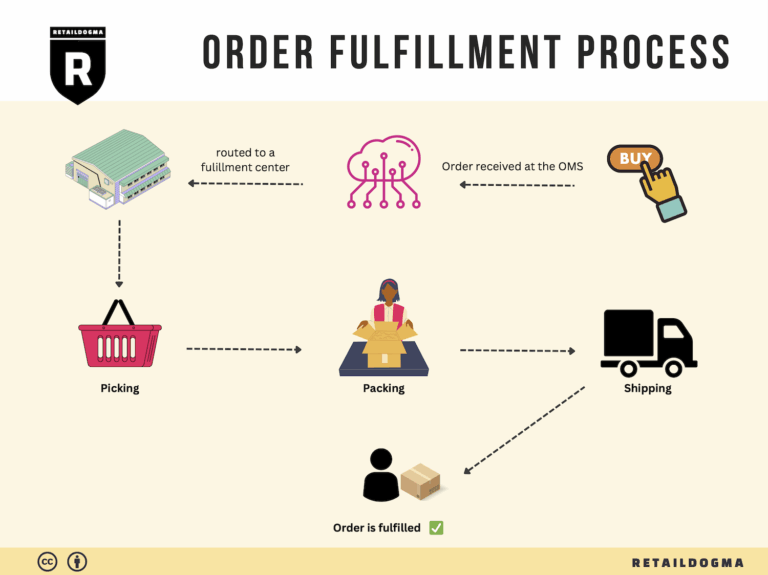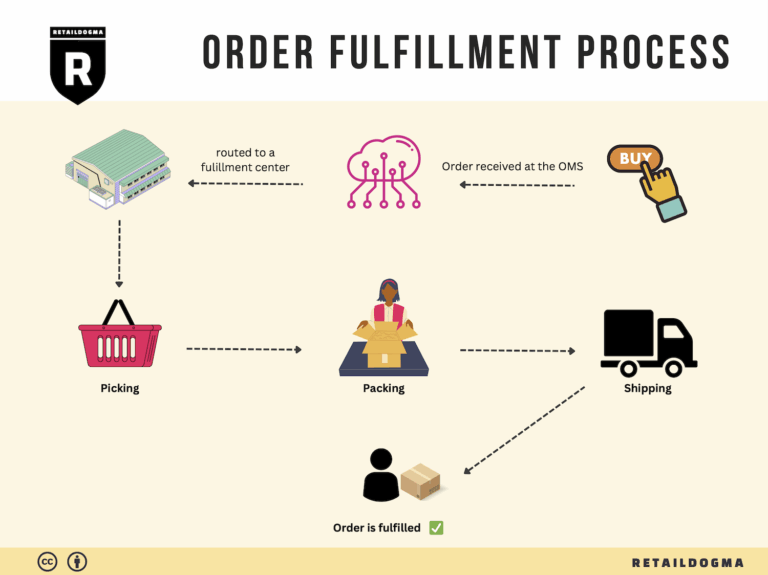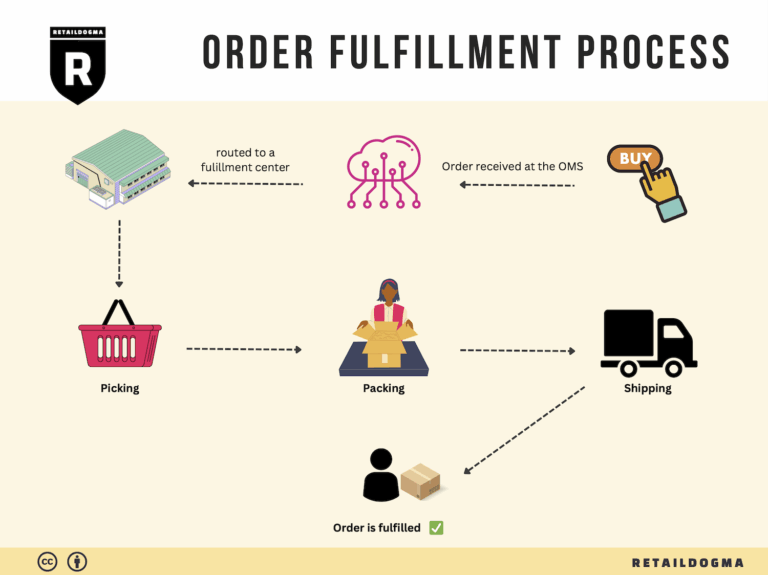What Is A Fulfillment Center? A Complete Guide (2025)
What is E-commerce Fulfillment? An Introduction for Growing Businesses
As an e-commerce business grows, many owners quickly find themselves overwhelmed by the demands of packing and shipping orders. The thrill of increasing sales can quickly turn into a logistical nightmare. Managing inventory, processing orders, and ensuring timely deliveries can consume valuable time and resources, diverting focus from strategic growth initiatives. This is where understanding e-commerce fulfillment becomes crucial.
Understanding E-commerce Fulfillment
E-commerce fulfillment is the process of getting a product from your warehouse or fulfillment center to the customer’s doorstep. It encompasses every step from receiving inventory, storing products, processing orders, and ultimately shipping them out. This process is not just about logistics; it plays a vital role in customer satisfaction and brand loyalty. Efficient fulfillment can turn a one-time buyer into a repeat customer, while delays or inaccuracies can damage your reputation.
What This Guide Covers
In this guide, we will explore various fulfillment models that can support your growing business. We will delve into Third-Party Logistics (3PL), Fulfillment by Amazon (FBA), and other options, helping you understand their unique advantages and potential drawbacks. You’ll learn about the core services these models offer, including inventory management, order processing, and shipping logistics.
Choosing the right fulfillment partner is a critical decision for any e-commerce business. We will provide practical tips on how to evaluate potential partners based on your specific needs, including aspects like scalability, technology integration, and customer service. Additionally, we will discuss pricing structures to help you understand the costs involved, ensuring you can budget effectively while maintaining profitability.
Empowering Smart Decisions
Our goal with this guide is to empower e-commerce business owners and operations managers to make informed decisions about their logistics strategies. By understanding the nuances of e-commerce fulfillment, you can streamline your operations, enhance your customer experience, and ultimately drive sustainable growth. Whether you are just starting or looking to scale, the insights shared here will equip you with the knowledge to navigate the complexities of fulfillment with confidence.
What You’ll Learn In This Guide
- What is E-commerce Fulfillment? An Introduction for Growing Businesses
- The Order Fulfillment Process: From ‘Buy’ Button to Customer’s Door
- Comparing Fulfillment Models: In-House vs. 3PL vs. Dropshipping
- A Deep Dive into Amazon FBA: Pros, Cons, and Who It’s For
- Core Services Offered by Fulfillment Centers
- How to Choose a Fulfillment Partner: A 6-Point Checklist
- Understanding Fulfillment Pricing: A Breakdown of Common Fees
- Frequently Asked Questions (FAQs) about Fulfillment
- Conclusion: Is Outsourcing Fulfillment the Right Move for Your Business?
- Important Disclaimer
The Order Fulfillment Process: From ‘Buy’ Button to Customer’s Door
1. Receiving Inventory
The order fulfillment process begins with receiving inventory, a critical step that sets the foundation for efficient logistics. This phase involves the arrival of goods at your warehouse, where they are checked against shipping documents, such as the Advance Shipping Notice (ASN). This document serves as a reference to ensure that the correct quantities and types of products have been delivered.
Importance: Accurate receiving is essential to maintain inventory integrity. Any discrepancies can lead to stockouts or overstocking, directly impacting sales and customer satisfaction. A well-organized receiving area can help mitigate these issues by allowing for quick identification of problems before they escalate.
Key Term: SKU (Stock Keeping Unit) – This unique identifier is crucial for tracking inventory throughout the fulfillment process. Each product should have a distinct SKU to streamline inventory management and ensure accurate order fulfillment.
2. Warehouse Storage
Once the inventory is received, the next step is warehouse storage. This involves placing the products in designated locations within the warehouse, which should be strategically organized for optimal efficiency. Effective warehousing relies on a well-implemented Warehouse Management System (WMS) that tracks the location of each SKU.
Importance: Proper storage practices not only facilitate easy access to products but also enhance inventory turnover rates. An organized warehouse reduces the time employees spend searching for items, thus speeding up the overall fulfillment process. Additionally, maintaining an accurate inventory count prevents stock discrepancies and enhances order accuracy.
Key Term: Warehouse Management System (WMS) – This software solution is vital for monitoring inventory levels, managing stock locations, and facilitating quick retrieval of products, ultimately driving efficiency in your operations.
3. Order Picking
After storage, the next phase is order picking, where items are selected from their storage locations to fulfill customer orders. This step typically uses pick lists—documents that outline the specific SKUs and quantities needed for each order. Employees or automated systems follow these lists to retrieve the necessary items.

Importance: Efficient picking processes are crucial for meeting customer expectations for fast delivery. The quicker and more accurately orders are picked, the more satisfied customers will be. Implementing strategies such as batch picking or zone picking can significantly improve efficiency, particularly during peak seasons.
Key Term: Pick List – This document or digital tool guides warehouse staff in retrieving items for customer orders, ensuring accuracy and speed in the picking process.
4. Order Packing
Once the items are picked, they move to the order packing stage. Here, products are carefully packaged for shipment. This includes selecting the appropriate packaging materials and creating packing slips that accompany the order. Packaging should not only protect the items but also enhance the customer’s unboxing experience.
Importance: Effective packing minimizes the risk of damage during transit and ensures that customers receive their orders as intended. Additionally, customized packaging can elevate the brand experience, turning a simple transaction into a memorable moment that encourages repeat purchases.
Key Term: Packing Slip – This document provides a summary of the items included in the shipment, serving both as a receipt for the customer and a reference for warehouse staff to ensure accuracy.
5. Shipping & Delivery
The final step in the order fulfillment process is shipping and delivery. Once orders are packed, they are labeled and dispatched to the chosen carriers. This stage is critical for ensuring that products reach customers in a timely manner. Real-time tracking systems provide visibility into the shipment’s journey, keeping customers informed.
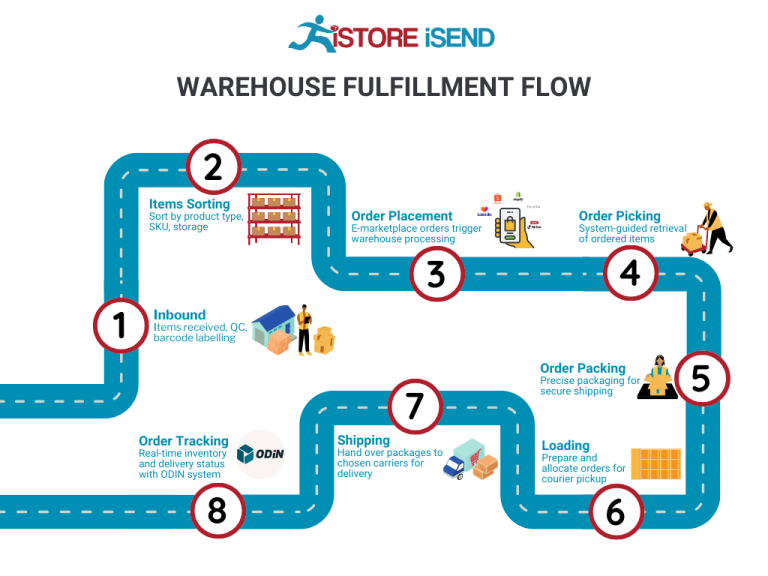
Importance: Fast and reliable shipping is a key driver of customer satisfaction. In fact, a significant percentage of customers consider shipping speed a decisive factor in their purchasing decisions. Implementing efficient shipping strategies and partnering with reliable carriers can enhance your fulfillment capabilities.
Key Term: Real-Time Tracking – This feature allows customers to monitor the status of their shipments, providing transparency and increasing trust in your brand.
By understanding and optimizing each of these steps, e-commerce businesses can create a seamless order fulfillment process that not only meets customer expectations but also drives operational efficiency. Adopting best practices in receiving, storage, picking, packing, and shipping will set your business up for sustainable growth in the competitive online marketplace.
Comparing Fulfillment Models: In-House vs. 3PL vs. Dropshipping
Fulfillment Model Comparison
| Model | Who Handles Inventory | Best For (Business Stage) | Key Advantage | Key Disadvantage |
|---|---|---|---|---|
| In-House Fulfillment | Business’s own team | Established businesses | Complete control over processes | High overhead costs and resource-intensive |
| Third-Party Logistics (3PL) | 3PL provider | Growing businesses | Scalability and reduced operational burden | Less control over fulfillment processes |
| Dropshipping | Supplier or dropshipper | Startups and small businesses | Low upfront investment and no inventory risk | Lower profit margins and potential quality issues |
In-House Fulfillment
In-house fulfillment refers to a model where the e-commerce business manages all aspects of order processing, inventory storage, and shipping internally. This approach is particularly advantageous for established businesses that have the necessary resources and infrastructure in place. By maintaining control over every aspect of the fulfillment process, companies can ensure quality, speed, and a tailored customer experience. This model allows for personalized packaging and direct oversight of inventory management, which can enhance brand recognition and customer loyalty. However, the key disadvantage of in-house fulfillment is the high overhead costs associated with warehousing, staffing, and logistics management. As businesses scale, the complexities of order fulfillment can become burdensome, requiring significant investments in technology and labor.
Third-Party Logistics (3PL)
Third-party logistics, or 3PL, involves partnering with an external logistics provider that specializes in warehousing, order fulfillment, and shipping. This model is ideal for growing businesses that may lack the space or manpower to handle logistics effectively. By outsourcing these operations, companies can focus on core business activities such as marketing and product development. The primary advantage of using a 3PL is scalability; businesses can easily adjust their logistics capabilities in response to demand fluctuations without the need for significant capital investment in infrastructure. Additionally, 3PL providers often have established networks and expertise in shipping, which can lead to faster delivery times and reduced costs. However, the downside is that businesses relinquish some control over the fulfillment process, which can lead to potential issues with quality assurance and customer service if the 3PL provider does not meet expectations.
Dropshipping
Dropshipping is a fulfillment method where the retailer does not keep products in stock. Instead, when a customer places an order, the retailer purchases the item from a third party—typically a wholesaler or manufacturer—who then ships the product directly to the customer. This model is particularly appealing to startups and small businesses, as it requires minimal upfront investment and eliminates the need for inventory management. The primary advantage of dropshipping is that it significantly lowers the financial risk for new entrepreneurs; they can offer a wide range of products without the burden of inventory costs. However, dropshipping also comes with challenges, such as lower profit margins due to reliance on third-party suppliers and potential quality control issues. Since retailers do not handle the products directly, they may face difficulties in ensuring that the products meet customer expectations, which can harm brand reputation if not managed carefully.
In conclusion, choosing the right fulfillment model depends on a variety of factors, including the business’s current stage, financial resources, and long-term goals. Each model offers unique advantages and disadvantages, and understanding these can help e-commerce business owners make informed decisions that align with their operational needs and customer expectations.
A Deep Dive into Amazon FBA: Pros, Cons, and Who It’s For
Understanding Fulfillment by Amazon (FBA)
Fulfillment by Amazon (FBA) is a service provided by Amazon that allows e-commerce sellers to store their products in Amazon’s fulfillment centers. Amazon then takes care of storage, packaging, and shipping of products directly to customers. This service not only simplifies logistics for sellers but also leverages Amazon’s extensive logistics infrastructure, allowing them to focus on scaling their businesses.
When a customer places an order for a product fulfilled by FBA, Amazon handles the entire process—from picking the product off the shelf to packing and shipping it. Sellers benefit from Amazon’s customer service and return handling, which can significantly enhance customer satisfaction.
How FBA Works
-
Set Up Your FBA Account: Sellers start by creating an Amazon seller account and enabling FBA. They can then list their products as FBA items.
-
Ship Products to Amazon: Sellers send their inventory to Amazon’s fulfillment centers. Amazon provides guidance on how to prepare and package products to meet their requirements.
-
Storage and Inventory Management: Once products arrive at the fulfillment center, they are stored until they are sold. Amazon uses advanced technology to track inventory levels and manage stock.
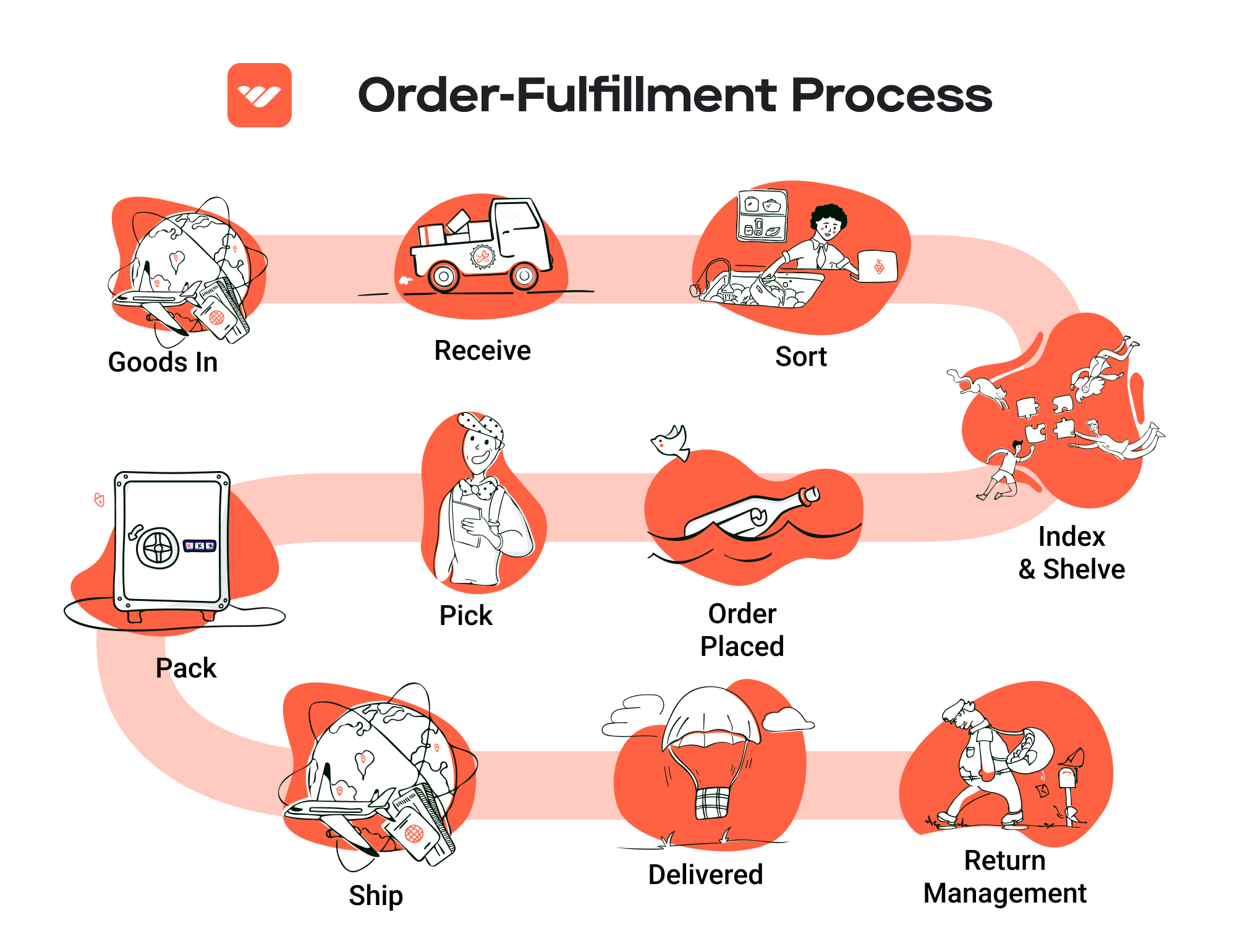
-
Order Processing: When a customer makes a purchase, Amazon picks, packs, and ships the product on behalf of the seller.
-
Customer Service and Returns: Amazon manages customer inquiries and returns, providing a seamless experience for both sellers and buyers.
-
Payment: Sellers receive payments for their sales, minus Amazon’s fees, which cover storage, fulfillment, and other associated costs.
Pros of FBA
Prime Eligibility
One of the most significant advantages of using FBA is that products become eligible for Amazon Prime. This means that Prime members can receive their orders with expedited shipping, which significantly increases the likelihood of purchase. Many consumers prefer shopping on Amazon due to the Prime shipping benefits, making it a crucial advantage for sellers.
Customer Trust
Amazon has built a strong reputation for reliability and customer service. By using FBA, sellers can leverage this trust. Products fulfilled by Amazon often have better visibility and credibility, leading to higher conversion rates. Customers are more likely to purchase products that are backed by Amazon’s customer service and return policies.
Multi-Channel Fulfillment
FBA also allows sellers to use Amazon’s fulfillment services for orders placed through other sales channels, such as their own e-commerce websites or other marketplaces. This multi-channel fulfillment capability enables sellers to streamline their logistics and maintain consistent inventory management across platforms.
Cons of FBA
High Fees
While FBA offers many benefits, it comes with a range of fees that can eat into profit margins. Sellers are charged for storage space in Amazon’s warehouses and for each order fulfilled. These fees can add up, particularly for sellers with slow-moving inventory or those selling lower-priced items.
Strict Inventory Rules
Amazon has stringent inventory management policies that sellers must adhere to. For example, sellers must ensure that their products meet Amazon’s quality standards and packaging requirements. Failure to comply can result in additional fees or even account suspension. This level of oversight can be challenging for sellers who prefer more control over their inventory management processes.
Commingling Risks
When sellers use FBA, their inventory may be commingled with inventory from other sellers. This means that if a customer receives a defective or damaged item, it can be challenging to identify the source of the issue. Commingling can also lead to potential issues with counterfeit products, as sellers may inadvertently ship items that are not genuine.
Who is FBA Best For?
Fulfillment by Amazon is particularly advantageous for:
-
Small to Medium-Sized Businesses: For businesses that are scaling up and looking for a reliable logistics partner, FBA can help reduce the burden of warehousing and shipping while providing access to Amazon’s vast customer base.
-
Sellers with High-Volume Products: Businesses that sell products with a high turnover rate can benefit from FBA’s efficient logistics, which can lead to increased sales and improved cash flow.
-
Brands Seeking Credibility: New sellers or those looking to establish credibility can leverage Amazon’s reputation and customer service to build trust with potential buyers.
-
Multi-Channel Sellers: Businesses that sell on multiple platforms can streamline their logistics by utilizing FBA for all their order fulfillment needs, allowing them to focus on marketing and product development.
In conclusion, Fulfillment by Amazon offers a powerful logistics solution for e-commerce sellers, providing access to Amazon’s extensive resources and customer trust. However, it is essential for sellers to carefully consider the associated costs and operational requirements to determine if FBA aligns with their business goals and growth strategies.
Core Services Offered by Fulfillment Centers
Inventory Management & Warehousing
Inventory management and warehousing are foundational services provided by fulfillment centers that significantly impact an e-commerce business’s operational efficiency. This service involves the systematic tracking of stock levels, ensuring that products are stored appropriately, and managing the flow of goods from suppliers to customers. Fulfillment centers typically utilize advanced Warehouse Management Systems (WMS) to optimize storage, monitor inventory levels in real-time, and automate reordering processes.
The benefits of effective inventory management are manifold. First, it helps prevent stockouts, which can lead to missed sales opportunities and customer dissatisfaction. Conversely, it also mitigates the risks of overstocking, which can tie up capital and increase holding costs. A well-managed inventory system allows e-commerce businesses to respond swiftly to market demands, ensuring that popular products are always available while minimizing excess stock. Furthermore, with efficient warehousing solutions, fulfillment centers can strategically position inventory closer to target markets, reducing shipping times and costs, thereby enhancing the overall customer experience.
Pick and Pack Services
Pick and pack services are crucial in the order fulfillment process, particularly for e-commerce businesses that require speed and accuracy in order processing. This service involves selecting items from the warehouse (picking) based on customer orders and then packaging them appropriately (packing) for shipment. Fulfillment centers employ trained staff and sophisticated technology to ensure that the right items are picked and packed efficiently.
The primary advantage of utilizing pick and pack services is the significant reduction in order processing time. As e-commerce customers increasingly expect fast shipping, fulfillment centers can ensure that orders are processed quickly—often within the same day—leading to improved customer satisfaction and loyalty. Additionally, many fulfillment centers offer customizable packaging options that align with a brand’s identity, enhancing the unboxing experience for customers. This not only helps in creating a memorable brand impression but also encourages repeat purchases and customer advocacy.
Kitting and Assembly
Kitting and assembly services offered by fulfillment centers cater to businesses that sell products that require bundling or assembly before shipping. This service involves combining various items into a single package or preparing products for sale by assembling components. For instance, a business that sells a DIY furniture kit may require its parts to be packaged together with instructions before being shipped to the customer.
The benefits of kitting and assembly are particularly relevant for businesses looking to streamline their operations and enhance their product offerings. By outsourcing this process, e-commerce businesses can save time and labor costs associated with manual assembly or bundling in-house. Furthermore, kitting can lead to increased sales opportunities by encouraging customers to purchase bundled products at a discounted rate, thereby boosting average order value. This service also allows businesses to present a more polished and professional product, ultimately improving customer satisfaction and reducing the likelihood of returns due to incomplete orders.
Returns Management (Reverse Logistics)
Returns management, often referred to as reverse logistics, is a critical service provided by fulfillment centers that focuses on efficiently handling product returns. Given that e-commerce businesses face higher return rates—often due to sizing issues, product dissatisfaction, or shipping errors—having a robust returns management process is essential. Fulfillment centers can manage the entire returns process, from receiving returned items to restocking and processing refunds.
The advantages of effective returns management are significant. First, it enhances customer satisfaction by providing a seamless returns experience, which can be a deciding factor for consumers when choosing to shop with a particular brand. Efficient handling of returns can also help businesses analyze return reasons, enabling them to make informed decisions about product offerings and improve quality control. Moreover, by streamlining the returns process, fulfillment centers can minimize the costs associated with handling returns, thus preserving profit margins for e-commerce businesses. This service not only fosters customer trust but also encourages repeat business, as customers are more likely to shop from a brand that offers hassle-free returns.
In conclusion, the core services offered by fulfillment centers—inventory management and warehousing, pick and pack services, kitting and assembly, and returns management—are integral to the success of e-commerce businesses. By leveraging these services, business owners can enhance operational efficiency, improve customer satisfaction, and ultimately drive sales growth.
How to Choose a Fulfillment Partner: A 6-Point Checklist
Location & Warehouse Network
Why It Matters:
The location of your fulfillment partner’s warehouses can significantly impact shipping costs and delivery times. A strategically placed warehouse network can reduce transit times and improve customer satisfaction by ensuring faster deliveries.
Questions to Ask:
– How many warehouses do you operate, and where are they located?
– How do you decide where to store my inventory?
– Can you provide options for both domestic and international shipping?
– Do you have the ability to ship from multiple locations to optimize delivery times?
Technology & Integrations
Why It Matters:
In today’s e-commerce landscape, technology plays a critical role in efficiency and accuracy. A fulfillment partner should offer robust software solutions that integrate seamlessly with your e-commerce platform, ensuring real-time updates and transparency throughout the order process.
Questions to Ask:
– What type of Warehouse Management System (WMS) do you use?
– Can your software integrate with my existing e-commerce platform (e.g., Shopify, Magento)?
– Do you provide real-time tracking for both me and my customers?
– What measures do you have in place for data security and privacy?
Specializations (e.g., Cold Storage, Oversized Items)
Why It Matters:
Your business may have unique needs that require specialized services. Whether you sell perishable goods that require cold storage or oversized items that need unique handling, ensuring your fulfillment partner can accommodate these requirements is crucial for maintaining product quality and customer satisfaction.
Questions to Ask:
– Do you have specialized facilities for handling specific types of products (e.g., cold storage, fragile items)?
– What experience do you have with businesses in my industry?
– How do you manage and track inventory for specialized products?
– Are there additional costs associated with these specialized services?
Scalability & Capacity
Why It Matters:
As your business grows, your fulfillment needs will evolve. A good fulfillment partner should be able to scale operations in line with your growth, whether that means accommodating seasonal spikes in demand or expanding your product range.
Questions to Ask:
– What is your current capacity for processing orders, and how do you handle peak seasons?
– Can you scale up quickly if my business experiences rapid growth?
– How do you manage inventory levels to avoid stockouts or overstock situations?
– Are there limitations on the types of products or volumes you can handle?
Pricing and Contracts
Why It Matters:
Understanding the pricing structure and contract terms is essential to avoid hidden costs and ensure that the partnership is financially viable. Transparent pricing allows you to accurately forecast expenses and maintain healthy margins.
Questions to Ask:
– What is your pricing model (e.g., per order, per item, monthly fees)?
– Are there any hidden fees (e.g., storage fees, pick-and-pack fees)?
– What are the terms of the contract? Is there flexibility to renegotiate as my business grows?
– Can you provide a detailed breakdown of costs associated with your services?
Customer Support & Reviews
Why It Matters:
Reliable customer support is critical for resolving issues quickly and maintaining smooth operations. Additionally, checking reviews and testimonials can provide insight into the partner’s reliability and customer service quality.
Questions to Ask:
– What level of customer support do you provide (e.g., dedicated account manager, 24/7 support)?
– How do you handle customer complaints or fulfillment errors?
– Can you provide references or case studies from businesses similar to mine?
– What is your average response time for customer inquiries or issues?
Conclusion
Choosing the right fulfillment partner is a pivotal decision that can impact your e-commerce business’s efficiency, customer satisfaction, and ultimately, your bottom line. By carefully considering the factors outlined in this checklist and asking the right questions, you can ensure that your selected partner aligns with your business goals and can support your growth effectively. Remember, a strong partnership in fulfillment can lead to enhanced operational capabilities, allowing you to focus on what you do best—growing your business.
Understanding Fulfillment Pricing: A Breakdown of Common Fees
Initial Setup Fees
Initial setup fees are charges that e-commerce businesses encounter when they first engage with a fulfillment provider. These fees can cover a variety of services, including account creation, software integration, and inventory setup. The cost is typically a one-time fee that varies based on the complexity of the integration and the number of SKUs being imported.
For example, if you’re integrating a robust Warehouse Management System (WMS) with your e-commerce platform, the setup fee may be higher due to the need for custom development or configuration. It’s essential to clarify what services are included in the setup fee and whether any additional costs may arise during the process.
Receiving Fees
Receiving fees are incurred when your inventory arrives at the fulfillment center. These fees cover the labor and processes involved in unloading, inspecting, and logging your products into the warehouse management system.
Typically, receiving fees are calculated based on the volume of goods received, often measured by the weight or number of pallets. For instance, if you send a shipment of 10 pallets, you might pay a fixed fee per pallet received. Understanding these costs can help you plan your shipments more effectively and avoid surprises in your logistics budget.
Storage Fees (per pallet/bin)
Storage fees are ongoing charges for keeping your inventory in the fulfillment center. These fees are generally calculated on a per-pallet or per-bin basis, depending on how your products are stored.
The cost can vary based on factors such as the location of the warehouse, the type of goods stored (e.g., high-value items may incur higher rates), and the duration of storage. It’s important to monitor your inventory levels regularly to minimize storage fees, as prolonged storage can quickly add up, impacting your overall profitability. Many fulfillment centers offer tiered pricing based on the volume of storage, so be sure to inquire about potential discounts for larger quantities.
Pick & Pack Fees (per item/order)
Pick and pack fees are charges for the labor involved in selecting items from inventory and preparing them for shipment. This fee is generally calculated per item or per order, depending on how the fulfillment center structures its pricing.
For instance, if your order consists of five different items, you might incur a pick fee for each item picked, plus a packing fee for the entire order. Some fulfillment centers offer a flat rate for pick and pack services, while others may charge based on the complexity of the order (e.g., custom packaging or special handling). Understanding these fees can help you optimize your order fulfillment process and potentially negotiate better terms based on your order volume.
Shipping Fees
Shipping fees cover the cost of transporting your products from the fulfillment center to your customers. These fees can vary significantly based on factors such as the shipping method chosen (e.g., standard, expedited, international), the destination of the shipment, and the weight and dimensions of the package.
Fulfillment centers often have contracts with major carriers, which may allow them to offer discounted shipping rates. It’s beneficial to compare shipping options and negotiate with your fulfillment provider to find the most cost-effective solutions for your business. Additionally, consider implementing a strategy for managing shipping costs, such as offering free shipping thresholds or utilizing a mix of shipping carriers based on delivery speed and cost.
Tips for Getting an Accurate Quote
-
Provide Detailed Information: When seeking quotes from fulfillment providers, offer detailed information about your business, including the number of SKUs, average order volume, and shipping destinations. This data helps providers tailor their quotes more accurately.
-
Ask About Hidden Fees: Inquire specifically about any additional fees that may not be immediately apparent, such as returns processing, special packaging, or seasonal surcharges. Understanding the full scope of costs will help you avoid surprises later on.
-
Request a Breakdown: Ask for a detailed breakdown of all fees associated with your fulfillment services. This transparency will allow you to compare different providers more effectively and make informed decisions.
-
Consider Your Growth: Discuss your future growth projections with potential providers. Some fulfillment centers may offer scalable pricing models that can accommodate your business as it grows, making it easier to manage costs over time.
-
Negotiate Terms: Don’t hesitate to negotiate pricing and terms based on your order volume and business needs. Many fulfillment providers are willing to work with you to establish a partnership that benefits both parties.
By understanding these common fulfillment pricing models and following the tips for obtaining accurate quotes, you can better manage your logistics costs and enhance your e-commerce operations.
Frequently Asked Questions (FAQs) about Fulfillment
1. What is order fulfillment in e-commerce?
Order fulfillment in e-commerce refers to the complete process of receiving, processing, and delivering orders to customers. This includes inventory management, order processing, packaging, shipping, and handling returns. Efficient order fulfillment is crucial for customer satisfaction and retention.
2. What is a fulfillment center?
A fulfillment center is a specialized warehouse designed to store and manage inventory, process orders, and ship products directly to customers. Unlike traditional warehouses that primarily focus on storage, fulfillment centers emphasize rapid order processing and delivery to enhance customer satisfaction.
3. What is the difference between a warehouse and a fulfillment center?
The primary difference lies in their functions:
– Warehouse: Focuses on storing goods and inventory management. It may not handle order processing or shipping directly.
– Fulfillment Center: Manages the entire order lifecycle from storage to shipping, often providing additional services like packaging and returns handling, tailored for e-commerce businesses.
4. What is a 3PL (Third-Party Logistics)?
A 3PL is a service provider that manages logistics and supply chain operations on behalf of another company. This includes services such as warehousing, inventory management, order fulfillment, and shipping. Partnering with a 3PL allows businesses to focus on core activities while leveraging the expertise and resources of logistics specialists.
5. How much do fulfillment services cost?
The cost of fulfillment services varies widely based on several factors, including the volume of orders, storage space required, packaging needs, and shipping destinations. Typically, fulfillment costs may include storage fees, picking and packing fees, shipping charges, and any additional services. It’s essential to request quotes from multiple providers to find a solution that fits your budget and needs.
6. How can fulfillment marketing enhance my business?
Fulfillment marketing integrates marketing strategies with the fulfillment process, allowing you to customize packaging and enhance the unboxing experience. This approach can increase brand awareness, improve customer loyalty, and create a unique experience that encourages repeat purchases.
7. What types of order fulfillment services are available?
The main types of order fulfillment services include:
– In-House Fulfillment: Managing fulfillment operations internally.
– Outsourced Fulfillment (3PL): Partnering with a third-party provider for logistics.
– Dropshipping: Sending orders directly from suppliers to customers without holding inventory.
– Hybrid Fulfillment: A combination of in-house and outsourced strategies to leverage the benefits of both.
8. How do I choose the right fulfillment partner?
When selecting a fulfillment partner, consider the following factors:
– Location: Proximity to your customer base to reduce shipping times and costs.
– Technology: Integration capabilities with your e-commerce platform and inventory management systems.
– Scalability: The ability to scale operations as your business grows.
– Services Offered: Ensure they provide all necessary services, including returns management and international shipping.
9. What is the typical order fulfillment process?
The typical order fulfillment process includes the following steps:
1. Receiving: Inventory is received and logged into the system.
2. Warehousing: Products are stored in an organized manner for easy access.
3. Order Processing: Customer orders are received and processed.
4. Picking: Items are selected from inventory based on orders.
5. Packing: Orders are packaged securely for shipping.
6. Shipping: Packages are shipped to the customer.
7. Returns Management: Handling any returns or exchanges as needed.
10. How can I improve my fulfillment efficiency?
To improve fulfillment efficiency, consider the following strategies:
– Leverage Technology: Use warehouse management systems (WMS) for real-time inventory tracking.
– Optimize Layout: Design your warehouse layout for efficient picking and packing.
– Streamline Processes: Regularly review and refine your fulfillment processes to eliminate bottlenecks.
– Train Staff: Invest in training for your team to ensure they are equipped with the skills needed for efficient operations.
– Monitor KPIs: Track key performance indicators (KPIs) like order accuracy and shipping times to identify areas for improvement.
Conclusion: Is Outsourcing Fulfillment the Right Move for Your Business?
Evaluating the Benefits of Outsourcing Fulfillment
Outsourcing fulfillment can be a game-changer for e-commerce businesses seeking to scale effectively. One of the primary benefits is the significant time savings. By partnering with a dedicated fulfillment service, you can redirect your focus from logistical challenges to strategic growth initiatives. This shift enables you to concentrate on marketing, product development, and enhancing customer relationships, which are critical for long-term success.
Scalability is another key advantage. As your business grows, so do your order volumes and logistical complexities. A proficient fulfillment partner can seamlessly adjust to your evolving needs, providing the infrastructure and resources necessary to handle increased demand without compromising service quality. This flexibility allows you to expand into new markets or product lines with confidence, knowing that your fulfillment operations can support your growth trajectory.
Moreover, tapping into the expertise of a fulfillment provider can enhance your operational efficiency. Established fulfillment services bring advanced technology, industry knowledge, and best practices that can streamline your processes and improve order accuracy. They can also offer insights into consumer behavior, helping you optimize your inventory management and shipping strategies.
However, choosing the right fulfillment partner is crucial. A mismatched provider can lead to inefficiencies and customer dissatisfaction. Look for a partner that aligns with your business goals, offers transparent communication, and demonstrates a commitment to customer service.
As you consider whether outsourcing fulfillment is the right move for your business, take a moment to audit your current shipping process. Assess your operational challenges, customer feedback, and growth aspirations. This evaluation will help you determine if partnering with a fulfillment service is the strategic next step to elevate your e-commerce operations and drive sustained success.
Important Disclaimer
⚠️ Important Disclaimer
The information in this guide is for educational purposes. Fulfillment services, pricing, and platform features change frequently. Always conduct your own due diligence and consult with providers directly before making business decisions.

